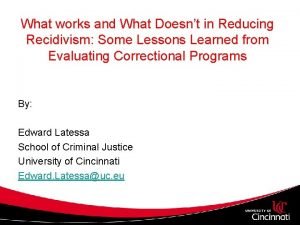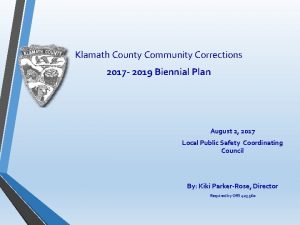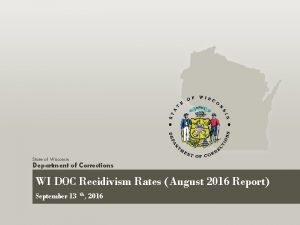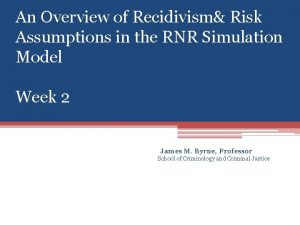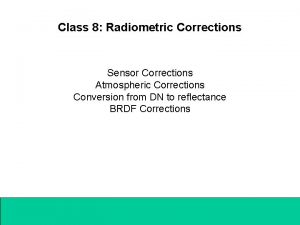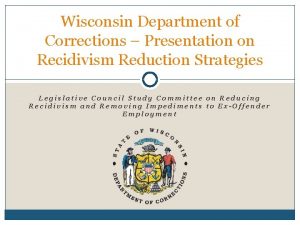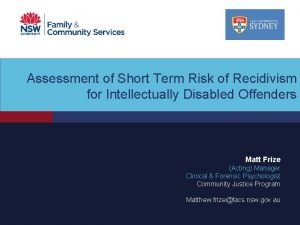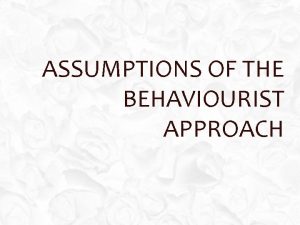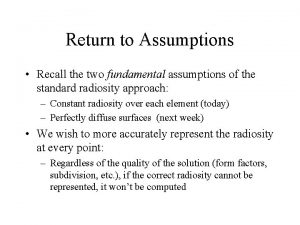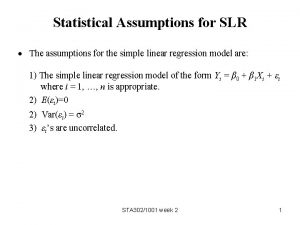An Overview of Recidivism Risk Assumptions in Corrections























- Slides: 23

An Overview of Recidivism& Risk Assumptions in Corrections Oct 2 2014

Presentation Overview: Assumptions about Risk of Recidivism • All US Corrections policies are based on assumptions about recidivism and risk levels that are important to understand: • Recidivism: What do we know about variation in recidivism patterns by offender, offense, location & time? • Risk Assessment: What is the likely risk distribution of the U. S. Offender Population? • Risk Reduction: What are the KNOWN factors linked to both risk level and risk reduction among known offenders?

Recidivism Defined • Definition: Previous research studies have defined risk in a variety of ways, including: re-arrest, reconviction, return to prison for a new criminal conviction, and return to prison for any reason (technical; new crime). • Measurement: These same studies have also incorporated both static ( re —arrest at 1, 2, or 3 year follow-up interval). ) and dynamic (probability of failure in a given month, post release, time to failure in months during a specified review period) measures of risk. • Time at Risk: The vast majority of recidivism studies have relied on official measures of recidivism, with re-arrest for any crime during a 1, 2 or 3 year follow-up period being the most common outcome measure employed. • RNR MODEL Assumption: For the purposes of our model, we will offer estimates of predicted risk levels based on a review of research using rearrest during a 3 year follow-up period as the primary outcome.

Recidivism of 272, 111 Former Inmates released in 1994 from Prisons across 15 States: 3 Year follow-up study 80 70 60 50 40 30 20 10 0 Rearrest reconviction return to prison( new crime) Return to prison( new crime/technical)

Patterns of Recidivism Research: We have looked closely at the key findings from this study of 272, 111 former inmates released in 1994 from prisons across 15 states. This cohort of state prisoners was followed up for 3 years after release from prison. Recidivism Level: A total of 67. 5% of these offenders were rearrested for a new offense within three years of release from prison (See Figure 1 below); two-thirds of those re-arrested were re-arrested in the first year after release. Time to Failure: Prisoners are more at risk for re-arrest during their first year post release. In fact, high risk times for re -arrest can be identified based on the re-analyses of the 1994 prison release cohort ( NRC 2007 report): Eight percent were re-arrested in 1 st month, 20% re-arrested by 3 rd month, 29. 9 % re-arrested by 6 th month, 44. 1% re-arrested by 12 th month, and 59. 2% re-arrested by 24 th month.

Probability of Arrest for a Violent, Property, or Drug Crime 36 Months After Release from Prison

Offender Characteristics and Recidivism • • • Gender Race/Ethnicity Age Chronic Offenders First Timers( in prison)

Gender and Recidivism • In the 1994 BJS recidivism study, 8. 7% of the release cohort (N=272, 111) were women. • Generally, women and men are arrested for different offenses. Women offenders are typically arrested for drug, property, or public order offenses – only 15% are arrested for violent offenses. • The 1994 release cohort of men were more likely than the release cohort of women to be rearrested (68. 4% versus 57. 6%), reconvicted (47. 6% versus 39. 9%), resentenced to prison for a new crime (26. 2% versus 17. 3%), and returned to prison with or without a new prison sentence (53. 0% versus 39. 4%). • Given these differences, it makes sense to consider the possibility that the factors that predict recidivism and/or the weights used to indicate the importance of specific factors in a prediction model should vary by gender.

Race/Ethnicity and Recidivism • In the 1994 BJS recidivism study, 50. 4% of the release cohort was classified as white, 48. 5% black, and 1. 1% other. • Separate classification by ethnicity identified 24. 5% of the cohort as Hispanic. Since Hispanics are included in both the white and black categories, it is impossible to distinguish racial/ethnic differences in reoffending in this cohort. • Nonetheless, Langan and Levin (2002) report that blacks were more likely than whites to be: rearrested (72. 9% versus 62. 7%), reconvicted (51. 1% versus 43. 3%), returned to prison with a new prison sentence (28. 5% versus 22. 6%), and returned to prison with or without a new prison sentence (54. 2% versus 49. 9%). • By comparison, non-Hispanics were more likely than Hispanics to be: rearrested (71. 4% versus 64. 6%); reconvicted (50. 7% versus 43. 9%); and, returned to prison with or without a new prison sentence (57. 3% versus 51. 9%). • Hispanics (24. 7%) and non-Hispanics (26. 8%) did not differ significantly in terms of likelihood of being returned to prison with a new prison sentence.

Age and Recidivism • For the offenders in the BJS recidivism cohort, the younger the prisoner when released, the higher the rate of recidivism. • Consider the following age-specific re-arrest levels: 82. 1% of those under age 18 were rearrested, 75. 4% of those 18 -24, 70. 5% of those 25 -29, 68. 8% of those 30 -34, 66. 2% of those 35 -39, 58. 4% of those 40 -44, and 45. 3% of those 45 or older. • It should be noted that since most incarcerated offenders have peaked in their offending careers before first incarceration, the deterrent effect of incarceration on overall crime rates is minimal (see Nagin, Cullen, & Jonston, 2009). • In the BJS recidivism study, only 21. 3% of the release cohort was under 24; 33. 2% were 35 or older at the time of their release.

Chronic Offenders and Recidivism • In the BJS study, about 48% of those offenders with 3 or fewer prior arrests (about 22% of the total cohort) were rearrested within 3 years of release from prison. • By comparison, over 80% of the offenders with more than 10 prior arrests (34. 2% of the cohort) were rearrested during this same review period. • Of course, within any cohort of criminal offenders, you will find a subgroup of offenders that are responsible for a disproportionate amount of the crimes committed by members of the cohort. • In the BJS study, 12% of the cohort had 35 or more total arrest charges, which accounted for 34. 4% of all cohort arrests (Langan and Levin, 2002, table 4). • Although we have no risk classification for offenders in the BJS study, it seems safe to assume that it would be possible to distinguish high risk from moderate and low risk offenders using prior arrests alone.

First Timers and Recidivism • In the BJS study, 56% of 1994 prison sample were first timers; 63. 8 % of all first-timers were re-arrested within 3 years. • By comparison, 44% of 1994 sample included repeaters; of this subgroup, 73. 5% were re-arrested within 3 years. • Over the past decade, repeaters comprised a larger proportion of all inmates; if this trend continues, the base rate (recidivism) will rise. • We suspect that what appears to be a prison first timer effect may be more precisely identified as a low risk offender effect; and not every first timer is a low risk offender.

Offense Types and Recidivism • Homicide: 40. 7% of these homicide offenders were rearrested for a new crime (not necessarily a new homicide) within 3 years; 1. 2% were rearrested for another homicide. • Rape: 46. 0% of these released rapists were rearrested within 3 years for some type of felony or serious misdemeanor (not necessarily another violent sex offense); 2. 5% were re-arrested for another rape during this review period. • Drug law violation: 66. 7% of those convicted of drug law violations were re-arrested within 3 years; 41. 2% were re-arrested for another drug offense. • Property offense: Released property offenders had higher recidivism rates than those released for violent, drug, or public-order offenses. An estimated 73. 8% of the property offenders released in 1994 were rearrested within 3 years, compared to 61. 7% of the violent offenders, 62. 2% of the public order offenders, and 66. 7% of the drug offenders; overall, about 25% were re-arrested for another property offense (23. 4% of released burglars; 33. 9% of released larcenists; 11. 5% of released thieves of motor vehicles; and 19. 0% of released defrauders).

Location and Recidivism • As the authors of the NRC report noted: “Although parolees make up a relatively small percentage of people under supervision of the criminal justice system, the total, as noted above, is now more than 600, 000 annually. • Moreover, most of the people released from prisons go to a small number of cities – about 20 – and to neighborhoods in those cities that have some of the highest crime rates in the nation (Travis, 2005). • Because parolees who have been released more than once before have very high reoffending rates their effect on these communities can be significant, and what can be done to support their successful reentry to society is therefore critical to neighborhood stability”(NRC, 2007: 16).

Timing of Recidivism • Focusing on the 1994 BJA cohort study, the authors of the National Research Council Report found that “Although risk for arrest declines over time for all three crime types, a much steeper decline occurs for property and drug offenders, whose arrest risk drops by nearly 50 percent between the first and 15 th month after release; for violent offenders, the decline is only about 20 percent from the first to the 15 th month out of prison” (2007: 4 -11). • Based on the arrest patterns of prison releases highlighted in the National Research Council report, it appears that the probability that an offender released from prison will be arrested for a violent crime during the first 36 months after release is low, ranging from a high of 1% in month 1 to a low of. 05% in month 35. • This finding underscores the fact that the pattern of violent recidivism varies significantly from the pattern of nonviolent recidivism.

Risk Assessment Research • There were a number of problems with risk assessment research studies, including lack of specificity on model development and validation and the inappropriate use of statistical procedures to draw the cutting points for inclusion in each risk category (high, medium, low). • In many jurisdictions, it appears that cutting points were defined in terms of group size and resource availability (e. g. a decision to draw the cutting point at no more than 10% high risk), rather than risk level differentiation (maximizing the difference between groups). • It is clear that the distribution varies by jurisdiction, by setting, and by type of instrument used.

Accuracy of Risk Prediction • Unfortunately, our review revealed that there is no systematic review or meta-analysis of risk assessment for the general population; the available reviews focus on a specific population; and there is an overall lack of quality validation studies that have been conducted to date. • Predictive accuracy varies by state, risk instrument design decisions and validation procedures, and inter-rater reliability. • Most validated risk models are only weakly to moderately accurate (. 60 -. 70 AUC) according to a recent review by Zhang and Farabee (2007).

Risk Assessment Instruments • Overall, it appears that only a very small number of risk variables are needed to accurately differentiate an offender population by risk into low, moderate, and high risk subgroups. These primary predictor variables fall into three categories: • Criminal history • Substance abuse • Employment • This finding has important implications for the development of risk reduction strategies, for two reasons: • first, because two of the risk variables – employment and substance abuse – are more akin to dynamic risk factors, in that they are amenable to change based on the status of the offender; • and second, because it focuses our attention on the problems of offenders that are most strongly related to risk.

Risk Level for Prison Releases based on the 2004 Prison Release Cohort High Risk, 20% Low Risk; 30% High Risk Moderate Risk Low Risk Moderate Risk; 50%

Summary of Key Risk-Related Assumptions • Risk Assumption # 1: High risk offenders comprise approximately 20% of the state prison population; 80% of these offenders are predicted to fail (re-arrest) within 3 years of release from prison. • Risk Assumption # 2: Moderate risk offenders comprise approximately 50% of the state prison population; 60% of these offenders are predicted to fail (re-arrest) within 3 years of release. • Risk Assumption # 3: Low risk offenders comprise approximately 30% of the state prison population; 40% of these offenders are predicted to fail (re-arrest) within 3 years of release. • Risk Assumption # 4: High rate re-offending: a small proportion of all releases (12%) account for a significant proportion (34. 4%) of all crimes committed (35 or more total arrests, pre and post release) by the release cohort (Langan & Levin, 2002). About half of all high risk offenders are high rate offenders; high rate offenders are rarely classified as medium or low risk.

What is linked to recidivism? • Direct Link ▫ Risk ▫ Substance Abuse Dependent ▫ Criminal lifestyle • Stabilizing Factors ▫ Employment ▫ Stable Family ▫ Housing • Destabilizers ▫ Mental Health Risk ▫ Housing (unstable, infrequent)

22 “Central Eight” risk factors for recidivism (Andrews, 2006) • • Antisocial Personality Pattern Antisocial Cognition Antisocial Attitudes Antisocial Peers • Substance Use/Abuse • Family Discord • Poor school and/or work performance • Few leisure or recreation activities

How can we address these known risk factors? # options to consider • 1. Increase treatment capacity • 2. Increase treatment quality • 3. Reduce incarceration and reinvest savings to treatment
 What works and doesn't in reducing recidivism download
What works and doesn't in reducing recidivism download Syarat multiple recidivism
Syarat multiple recidivism Market risk assessment
Market risk assessment Which of the following is a sentence fragment marina
Which of the following is a sentence fragment marina Essay corrections
Essay corrections Larch corrections center
Larch corrections center Law, public safety, corrections and security answer key
Law, public safety, corrections and security answer key Criminal thinking worksheets
Criminal thinking worksheets Florida department of corrections mission statement
Florida department of corrections mission statement Corrections fatigue
Corrections fatigue Orange county community corrections
Orange county community corrections Unraid write corrections to parity
Unraid write corrections to parity Oooosex
Oooosex Accounting changes and error corrections
Accounting changes and error corrections Wisconsin department of corrections
Wisconsin department of corrections Debye huckel limiting law
Debye huckel limiting law Joanna carns
Joanna carns Qi corrections
Qi corrections Corrections criminal justice
Corrections criminal justice Latitude correction gravity formula
Latitude correction gravity formula Intro to corrections
Intro to corrections Current and future issues in corrections
Current and future issues in corrections Geometric corrections
Geometric corrections Comma splice examples and corrections
Comma splice examples and corrections
